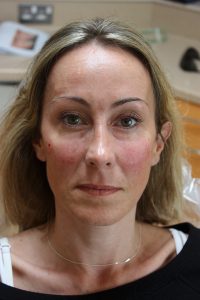Dermal Filler to replace lost volume and facial contours.
Modern Dermal fillers can work wonders in restoring facial volume and contours.
Dermal fillers aren’t the same as neurotoxins like Botox, Azzalure and Dysport. Botox “freezes” muscles to reduce wrinkles, while fillers smooth out skin by filling wrinkles or replacing Volume in deeper layers underneath the skin. Most fillers, such as Restylane and Juvéderm, use hyaluronic acid. Hyaluronic acid gives skin a plump, hydrated look thanks to its ability to store moisture. It’s used topically to moisturize, but a cream or serum can’t restore lost volume—only injectable hyaluronic acid can. Once injected, it can add to the natural plumping action or replenish your body’s natural production of hyaluronic acid, which diminishes as you age.
Crosslinked hyaluronic acid fillers, i.e. Juvederm, Restylane, Belotero etc., also act as moisture reservoirs. In fact, hyaluronic acid fillers attract moisture, and it is important not to overdo the treatment; as a result, it will improve over time after the treatment. Hyaluronic acid fillers also stimulate collagen production in the skin.
Profhilo, a filler of a different kind:
This filler acts a “Biostimulator”. Small amounts of the product is injected in several areas of the face and neck. 2- 4 sessions are required and it will take a few weeks until the result is fully visible.
Treatment Areas
- Upper face: Forehead, Temples, Cheekbones
- Midface: cheek, tear trough, nose
- Lower face: Jawline, Chin, lips and mouth area
Treatment Examples


Before and after Tear Trough and Midface treatment


Treatment of lips to increase volume and define the contours
What are Dermal fillers made from?
If you want to reduce facial wrinkles and lines, dermal fillers made from Hyaluronic Acid may be a good choice as a dermal filler. This is a substance which is highly compatible with the human body. Hyaluronic Acid or Hyaluronan (HA) is found in almost every single living thing. HA is a network that transfers essential nutrients from the bloodstream to skin cells.
Hyaluronic acid is a natural substance found in your body. It is found in high concentrations in soft connective tissues and in the fluid around your eyes. It’s also in some cartilage, joint fluids, and skin tissue. It is produced in laboratories and has become the most popular injectable filler.
Hyaluronic Acid is also often injected into the aching joints of people with arthritis to ease inflamed joints and provide extra cushioning.
